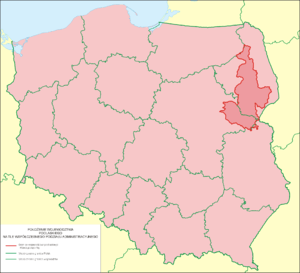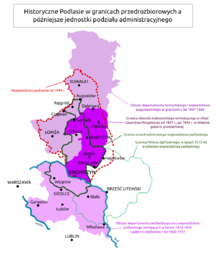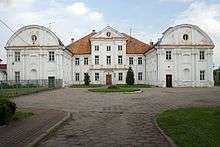Podlachia
| Podlachia Podlasie | ||
|---|---|---|
| ||
 Proper Podlachia | ||
| Country |
| |
| Former capital | Drohiczyn | |
| Time zone | CET (UTC+1) | |
| • Summer (DST) | CEST (UTC+2) | |

Podlasie,[1] or Podlachia[2] (Polish: Podlasie, Belarusian: Падляшша Padlyashsha) is a historical region in the eastern part of Poland. Between 1513 and 1795 it was a voivodeship with the capital in Drohiczyn. Now the part north of Bug River is included in the modern Podlaskie Voivodeship with the capital in Białystok.
Etymology
The region is called Podlasie, Podlasko or Podlasze in Polish, Palenkė in Lithuanian, Padljašša (Падляшша) in Belarusian, Pidlissja (Підлісся), Pidljasije (Підлясіє), Pidlyashya (Підляшшя) or Pidljakhija (Підляхія) in Ukrainian, Podljas’e (Подлясье) in Russian, "Podlyashe" (פּאָדליאַשע) in Yiddish, and Podlachia in Latin.
There are two opinions regarding the origin of the name of the region. Commonly people derive it from the Slavic word les or las meaning "forest", i.e., it is an "by the wood(s)" or "area of forests", making Podlachia close in meaning to adjacent Polesia. The theory has been questioned, as it does not properly take into consideration the vowel shifts "a" > "e" > "i" in various Slavic languages (in fact, it mixes vowels form different languages).
The second opinion holds that the term comes from the expression pod Lachem, which may be translated literally as "under the Poles" (see: Lechia). Some claim it to mean "under Polish rule", though in the Middle Ages Podlachia was only partially under Polish rule, and since 1446 until 1569 the area belonged to the Grand Duchy of Lithuania. A better variant of this theory holds that the name originates from the period when the territory was within the Trakai Voivodeship of the Grand Duchy of Lithuania, along the borderline with the Mazovia province, primarily a fief of the Poland of the Piasts and later on part of the Kingdom of Poland of the Jagiellons. Hence pod Lachem would mean "near the Poles", "along the border with Poland". The historical Lithuanian name of the region, Palenkė, has exactly this meaning.
Subregions
Podlasie is divided along the Bug River, at which the traditional capital Drohiczyn lies, into northern and southern parts. The former is included in the modern-day Podlaskie Voivodeship with its capital at Białystok (the historical boundary goes exactly through the city). Sometimes, Siedlce has been considered the capital of the region.
History
Throughout its early history, Podlasie was inhabited by various tribes of different ethnic roots. In the 9th and 10th centuries, the area was likely inhabited by Lechitic tribes in the south, Baltic (Yotvingian) tribes in the north, and Ruthenian tribes in the east. Between the 10th and 14th centuries, the area was part of the Ruthenian principalities and Polish and Mazovian Piast states. The area became perhaps a part of the Medieval Slavic territory of Cherven Cities. In the 14th century the area was annexed by the Grand Duchy of Lithuania, though later on it still briefly fell under Mazovian Piast rule. In 1446 Podlachia became part of the Grand Duchy, but since 1496 southwestern parts of Podlachia (Drohiczyn Land and Mielnik Land) and since 1501 the northern part (Bielsk Land) used Polish law instead of Lithuanian. In 1513 King Sigismund I the Old formed the Podlaskie Voivodeship (adjective of Podlasie). In 1566 the southeastern part of Podlachia became part of the newly formed Brest Litovsk Voivodeship as the Brest Litovsk County. In 1569, after the Union of Lublin, Podlasie was ceded to the Kingdom of Poland. It was the northernmost part of the Lesser Poland Province of the Polish Crown. The voivodeship was divided in three lands: the Drohiczyn, Mielnik and Bielsk Land. In the 18th and 19th century the private town of Białystok became the main center of the region, thanks to the patronage of the Branicki family and the textile industry development. After the Third Partition of Poland in 1795 Podlachia was divided between the Kingdom of Prussia, the Habsburg Monarchy and the Russian Empire. In 1807 the western part of Podlachia became part of the Duchy of Warsaw, a semi-independent Polish entity, while the eastern part including Białystok fell under Russian rule. In the 19th century the region was a stronghold of Polish resistance against Russian rule. The last partisan of the January Uprising Stanisław Brzóska operated here until 1865. He was hanged publicly by the Russians in Sokołów Podlaski in May 1865. Poland regained Podlachia after restoring independence in 1918.
Ethnic situation
Podlasie is the land of the confluence of cultures – mainly Polish and Belarusian – and is indicative of the ethnic territories limits. East of Podlasie lie ethnically non-Polish lands, while westward ethnically non-Ruthenian. Today, Polish is spoken in western, northern and southern Podlasie, while Belarusian in eastern.
Until the 19th century, Podlasie was populated by the Polish-speaking yeomanry (drobna szlachta), Jews (primarily in towns), and Ruthenian Greek-Catholics speaking a dialect related to modern Ukrainian – the so-called Khakhlak (Chachlak) dialect, which derived its name from a derogatory term for Ukrainians (khakhol or khokhol being the name of the traditional haircut of Ukrainian Cossacks).
In the 19th century, the inhabitants of Podlasie were under the rule of the Russian Empire, with southern Podlasie constituting a part of Russian-controlled Congress Poland. After 1831, Russian authorities forbade the Greek-Catholic faith in northern Podlasie and it disappeared from the area. In 1875, Russians forbade this rite in southern Podlasie as well, and all Greek-Catholic inhabitants were forced to accept the Eastern Orthodox faith. However, the resistance of the local people was surprisingly strong and Ruthenian speakers from this area rejected the separation from the pope. In 1874, blessed Wincenty Lewoniuk and 12 companions were killed by Russian soldiers in Pratulin. In reaction to these measures, the Ruthenians of southern Podlasie began to identify themselves with the national movement of the Roman Catholic Poles. To preserve the full communion with the pope, they have changed the rite from eastern to Latin before the compulsory conversion of Greek Catholics into Orthodoxes. In 1912, Russian authorities issued a tolerance edict that made it possible to change confessions from Orthodox to Roman Catholic (but not to Greek-Catholic, which has been completely deleted). A majority of the inhabitants of southern Podlasie changed their faith from Orthodox to Roman Catholic. At present, very few people in this area continue speaking Ruthenian (Ukrainian) and nearly all consider themselves Poles. Meanwhile, eastern part of northern Podlasie is still populated by Belarusians.
Podlasie is also the cultural center of Poland's small Tatar minority as well. After the annexation of eastern Poland into the Soviet Union following World War II, Poland was left with only 2 Tatar villages, Bohoniki and Kruszyniany (both outside the historical borders of Podlachia). Some Tatars from the territories annexed to the USSR have been repatriated to Poland and clustered in cities, particularly Białystok. In 1925 the Muslim Religious Union (Muzułmański Związek Religijny) was formed in Białystok. In 1992, the Union of Tatars of the Republic of Poland (Związek Tatarów Rzeczypospolitej Polskiej) with autonomous branches in Białystok and Gdańsk began operating.
Cities and towns


| City | Population (2015/16)[3] | Pop. (1931) | Administrative division | Additional information | |
|---|---|---|---|---|---|
| 1. | Brest | 340,141 | 48,431 | Brest Region | Part of Podlachia until 1566, after 1566 it is rather considered part of Polesia; former royal city of Poland. |
| 2. | Białystok | 295,981 | 91,335 | Podlaskie Voivodeship | Former private town of the Branicki family. |
| 3. | Biała Podlaska | 57,414 | 17,549 | Lublin Voivodeship | Part of Podlachia until 1566, after 1566 it was rather considered part of Polesia, nowadays the area is referred to as Southern Podlasie; former private town of the Radziwiłł family. |
| 4. | Kobryn | 52,655 | 10,101 | Brest Region | Part of Podlachia until 1566, after 1566 it is rather considered part of Polesia. |
| 5. | Augustów | 30,449 | 12,147 | Podlaskie Voivodeship | Former royal city of Poland. |
| 6. | Byaroza | 29,408 | 4,521 | Brest Region | Area was part of Podlachia until 1566, after 1566 it is rather considered part of Polesia. |
| 7. | Bielsk Podlaski | 26,336 | 7,029 | Podlaskie Voivodeship | Former royal city of Poland, capital of Bielsk Land. |
| 8. | Hajnówka | 21,559 | Podlaskie Voivodeship | ||
| 9. | Sokołów Podlaski | 18,720 | 9,901 | Masovian Voivodeship | Former private town of the Kiszka and Radziwiłł families. |
| 10. | Pruzhany | 18,459 | 8,013 | Brest Region | Part of Podlachia until 1566, after 1566 it is rather considered part of Polesia. |
| 11. | Międzyrzec Podlaski | 17,117 | 16,837 | Lublin Voivodeship | Part of Podlachia until 1574, after 1574 it was rather considered part of Polesia, nowadays the area is referred to as Southern Podlasie, former private town. |
| 12. | Łapy | 16,005 | 6,674 | Podlaskie Voivodeship | |
| 13. | Siemiatycze | 14,766 | 6,816 | Podlaskie Voivodeship | Former private town of the Jabłonowski family. |
| 14. | Włodawa | 13,643 | 8,519 | Lublin Voivodeship | Part of Podlachia until 1566, after 1566 it was rather considered part of Polesia, nowadays the area is referred to as Southern Podlasie; former private town. |
| 15. | Zhabinka | 13,357 | Brest Region | Area was part of Podlachia until 1566, after 1566 it is rather considered part of Polesia. | |
| 16. | Węgrów | 12,796 | 9,416 | Masovian Voivodeship | Former private town of the Radziwiłł family, westernmost town of Podlachia. |
| 17. | Malaryta | 11,823 | Brest Region | Area was part of Podlachia until 1566, after 1566 it is rather considered part of Polesia. | |
| 18. | Mońki | 10,352 | Podlaskie Voivodeship | ||
| 19. | Wysokie Mazowieckie | 9,503 | 3,977 | Podlaskie Voivodeship | Former private town. |
| 20. | Kamyenyets | 8,405 | 3,001 | Brest Region | Part of Podlachia until 1566, after 1566 it is rather considered part of Polesia. |
| 21. | Łosice | 7,099 | 5,026 | Masovian Voivodeship | Former royal city of Poland. |
| 22. | Terespol | 5,815 | 2,308 | Lublin Voivodeship | Part of Podlachia until 1566, after 1566 it was rather considered part of Polesia, nowadays the area is referred to as Southern Podlasie; former private town. |
| 23. | Choroszcz | 5,782 | 2,905 | Podlaskie Voivodeship | |
| 24. | Vysokaye | 5,164 | 2,739 | Brest Region | Area was part of Podlachia until 1566, after 1566 it is rather considered part of Polesia. |
| 25. | Ciechanowiec | 4,840 | 4,029 | Podlaskie Voivodeship | Former private town. |
| 26. | Brańsk | 3,867 | 4,204 | Podlaskie Voivodeship | Former royal city of Poland. |
| 27. | Knyszyn | 2,850 | 4,123 | Podlaskie Voivodeship | Former royal city of Poland, royal residence of King Sigismund II Augustus. |
| 28. | Szepietowo | 2,282 | Podlaskie Voivodeship | Youngest town of Podlachia. | |
| 29. | Kosów Lacki | 2,187 | Masovian Voivodeship | ||
| 30. | Drohiczyn | 2,125 | 2,309 | Podlaskie Voivodeship | Historical capital of Podlasie, former royal city of Poland, capital of Drohiczyn Land. |
| 31. | Tykocin | 2,014 | 3,290 | Podlaskie Voivodeship | |
| 32. | Goniądz | 1,900 | 3,449 | Podlaskie Voivodeship | Former royal city of Poland. |
| 33. | Mordy | 1,819 | 3,287 | Masovian Voivodeship | Former private town of the Radziwiłł and Ciecierski families. |
| 34. | Rajgród | 1,626 | 2,432 | Podlaskie Voivodeship | Former royal city of Poland. |
| 35. | Kleszczele | 1,345 | 2,029 | Podlaskie Voivodeship | Former royal city of Poland. |
| 36. | Suraż | 1,008 | 1,379 | Podlaskie Voivodeship | Former royal city of Poland. |
References
- ↑ Bedford, Neal (2008). Poland. Lonely Planet. pp. 138–139. ISBN 978-1-74104-479-9.
- Chorzempa, Rosemary A. (2009). Polish Roots. Genealogical Publishing Com. pp. 84–85. ISBN 0-8063-1378-1.
- Oskar Halecki; W: F. Reddaway; J. H. Penson. The Cambridge History of Poland. Cambridge University Press. pp. 363–364. ISBN 978-1-00-128802-4.
- The Gate of Podlasie
- Podlasie
- Introducing Mazovia & Podlasie
- Podlasie24
- Podlasie Jazz Festival - ↑ Paul Robert Magocsi. Historical Atlas of Central Europe: From the early fifth century to the present. Thames & Hudson, 2002.
- William Fiddian Reddaway. The Cambridge History of Poland: Volume 2. 1971.
- Zigmantas Kiaupa. The History of Lithuania. Baltos Lankos, 2005. p.52.
- Zenon E. Kohut, Bohdan Y. Nebesio, Myroslav Yurkevich. Historical Dictionary of Ukraine. Scarecrow Press, 2005.
- Jerzy Kłoczowski. A History of Polish Christianity. Cambridge University Press, 2000, p.268. - ↑ http://www.polskawliczbach.pl/Miasta
